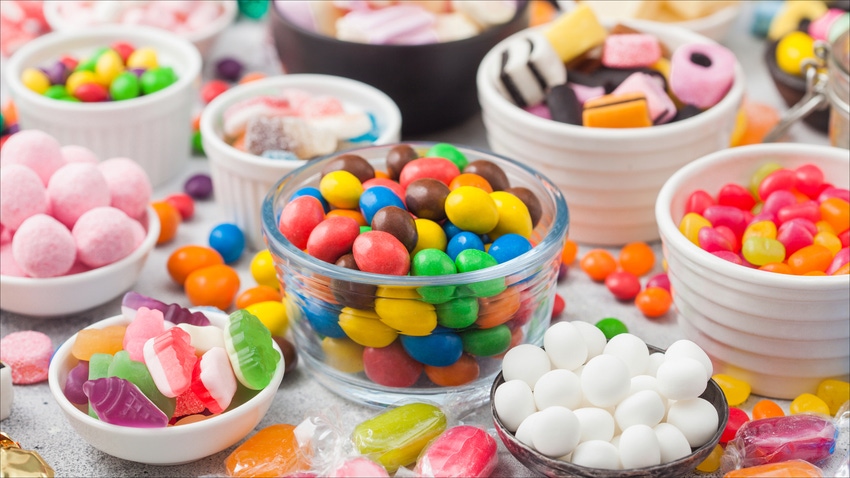The Steady Appeal of Sweets
Confectionery remains a solid niche in the licensing industry.

Loads of us like to eat, drink and be merry. Compared to categories like apparel, accessories and video games, food and beverage might not be the largest or fastest growing, but it’s still showing respectable growth. Licensing International’s 2023 Global Licensing Industry Study, reporting on Global Sales Revenue from Licensed Merchandise and Services by Product Category, found food and beverage grew by 6% in 2022. The study also reported 2.29% of industry leaders surveyed expect to see growth in food and beverage. One U.S.-based agent was quoted in the report saying, “Corporate food brands are trending and appealing to kidult audiences.”
Confectionery certainly occupies a sweet spot in food and beverage licensing. Data Bridge Market Research reports that the candy market was valued at $226.38 billion in 2021 and is expected to reach $308.39 billion by 2029, registering a CAGR of 3.94% during the forecast period of 2022 to 2029.
Licensing sees its share of confectionery deals, and not just around the holidays as some might suppose. In October, The Royal Horticultural Society (RHS) announced a partnership in the confectionery category, with The House of Sarunds, a distributor of chocolate and confectionery, to produce a special RHS range of English chocolate, confectionery and biscuits. November saw luxury candy brand, Sugarfina, collaborating with Hasbro for a version of the Candy Land board game complete with gourmet candies. In January, Trolli, a sour gummi brand, announced a partnership with projected top pro football draft pick and college football award-winning quarterback, Caleb Williams. As part of the collaboration, Trolli released an exclusive, limited-edition “Caleb Williams Mix” pack of Trolli Sour Brite Crawlers.
Sometimes confectionery deals don’t even involve consumable goods. Last August, Asembl secured the first Australian brand extension partnership for Perfetti Van Melle’s Mentos brand, launching a gel-design air freshener range with Balco Brands. And while kids love both licensed products and sweets … so do adults.
“For kids or adults, confectionery brands represent a feeling of carefree fun,” says Nicole Maiorino, associate vice president, brand management, Beanstalk. “Within food and beverage, of course, they are extending in close-to-core adjacencies such as frozen novelty, other confectionery areas (e.g., Sour Patch Kids x Trident) and snacks, but we are also seeing them meet consumers at different price points and retail channels.”
Sweet Shots of Energy
One food and beverage space that seems to be on a growth trajectory is sports drinks, whether that’s G Fuel’s numerous licensed beverages for gamers detailed in License Global��’s February issue, or candy brand, Millions, recently announcing partnership with C4 Energy.
“Confectionery has taken the sports nutrition world by storm with flavored pre- and post-workout drinks,” says Maiorino. “There are candy-flavored energy drinks and alcoholic beverages. And there are collaborations with premium purveyors such as Jeni’s and Van Leeuwen. The emotional connection remains, especially for older consumers who can directly connect confectionery to their childhood. And the surprise element of collaborations helps them re-engage with the core product.”
Maiorino says consumers care about what brands stand for and how products are made. That means they’re not just focusing on what the products taste or look like.
“No matter the brand, it must have a unique personality, a compelling origin story and an evolving marketing strategy to stay relevant to consumer interests,” says Maiorino. “From a licensed product perspective, this means you can’t just color splash everything.”
In January, HI-CHEW, a global chewy candy company, selected Beanstalk to extend its brand into worldwide food and beverage and lifestyle licensing. Maiorino points to that brand as a good example.
“HI-CHEW actually presents an interesting case for licensing,” explains Maiorino. “While their packaging is bright and colorful, their product is muted due to the fact that they do not use any artificial colors. So, lifestyle products can reflect the brand’s packaging aesthetic – while consumables will need to be true to the integrity of the core product and deliver the fruitful, mouthwatering flavor that the candy does.”
Read more about:
GlobalLicense Global OriginalG FuelPerfetti Van MelleMentosBeanstalkRoyal Horticultural SocietyThe Royal Horticultural SocietyAbout the Author(s)
You May Also Like








